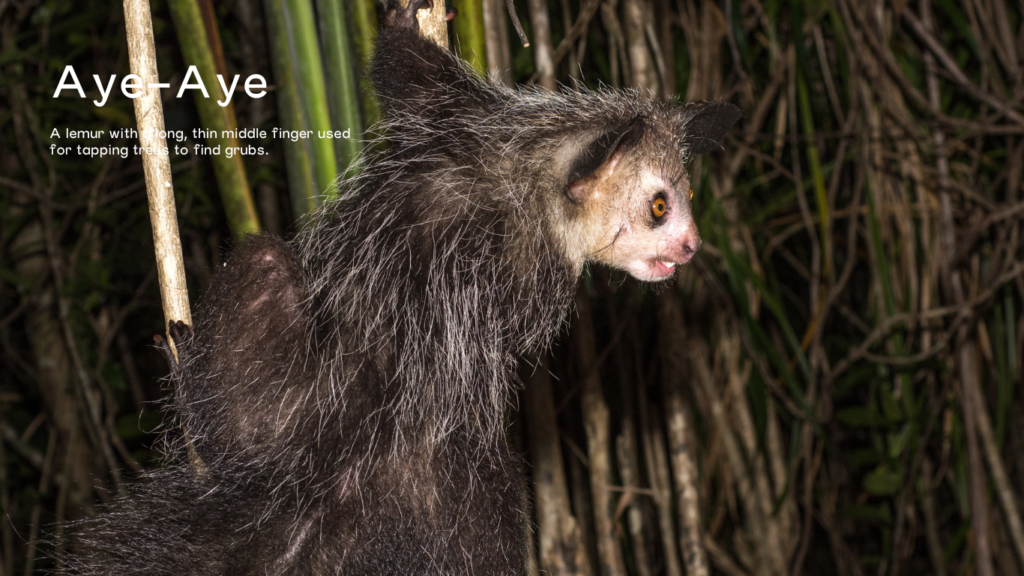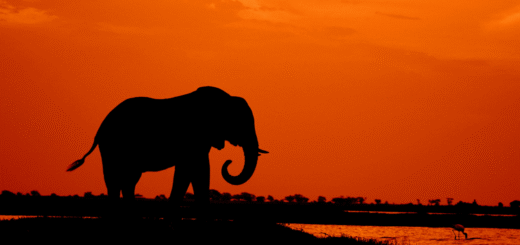Aye-Aye: The Mysterious Primate of Madagascar
Aye-Aye (Daubentonia madagascariensis) is one of the most peculiar and misunderstood primates in the world. Native to the island of Madagascar, this nocturnal creature has captivated scientists, researchers, and the public alike due to its strange physical characteristics and unusual behaviors. Despite its fascinating attributes, the Aye-Aye has historically been misunderstood and even feared by the local people, leading to unfortunate consequences for its survival. This article delves into the biology, behavior, and conservation status of the Aye-Aye, as well as its cultural significance in Madagascar.

Physical Characteristics
The Aye-Aye is a small primate, weighing between 5 to 6 pounds and measuring around 2 to 3 feet from head to tail. Its appearance is quite distinct, setting it apart from other lemurs and primates. One of its most notable features is its long, bony middle finger, which it uses in ways that few other mammals do. This finger, nearly as long as its entire forearm, is extremely flexible and highly sensitive, allowing the Aye-Aye to perform tasks that other animals cannot.
This unusual digit is complemented by large, sharp incisors that never stop growing. Similar to rodents, the Aye-Aye’s teeth are adapted for gnawing and are especially useful when the animal is accessing food hidden under tree bark or other tough surfaces. The Aye-Aye’s face is characterized by large, expressive eyes that help it see in the dark. These eyes are complemented by large, bat-like ears that are finely tuned to detect even the faintest sounds. Its fur is typically dark brown or black with tufts of white, which provides some camouflage in the shadowy forests of Madagascar.
Read to The Fascinating World of Axolotls: A Unique Marvel of Nature
Diet and Foraging Behavior
One of the Aye-Aye’s most intriguing characteristics is its unique method of finding food, known as “percussive foraging.” This technique involves tapping on tree trunks with its elongated middle finger, allowing the Aye-Aye to listen for the hollow sounds of tunnels created by insects. This remarkable adaptation is rare among mammals and is shared only by a few other species, such as woodpeckers. When the Aye-Aye detects an insect tunnel, it uses its sharp teeth to gnaw through the wood and then inserts its thin middle finger into the opening to fish out the insects or larvae inside.
The Aye-Aye’s diet is not limited to insects. It is omnivorous, and its diet includes fruit, seeds, nectar, fungi, and even small animals. However, larvae and grubs found inside tree trunks remain its primary food source. In captivity, Aye-Ayes have also been observed enjoying coconut flesh, which they access by piercing the shell with their strong incisors.
Reproduction and Social Behavior
The Aye-Aye is a solitary animal, coming together with others of its kind only during the mating season. Little is known about the Aye-Aye’s reproduction in the wild, as it is a highly secretive creature. However, in captivity, Aye-Ayes have a gestation period of about 170 days, after which the female gives birth to a single offspring. The young Aye-Aye is heavily dependent on its mother for the first few months of life, clinging to her fur as she moves through the forest.
Due to their solitary nature, Aye-Ayes have large, overlapping home ranges, which are often marked by scent glands to warn other individuals of their presence. These territorial markers help reduce conflict between individuals, as encounters with other Aye-Ayes are generally brief and infrequent. Communication among Aye-Ayes is limited to vocalizations, particularly during the breeding season when males emit distinctive calls to attract females. Aye-Ayes are also known to emit a series of grunts, shrieks, and hisses, especially when threatened or alarmed.
Conservation Status
The Aye-Aye is currently listed as Endangered by the International Union for Conservation of Nature (IUCN). Habitat destruction is one of the primary threats to the Aye-Aye population, as Madagascar’s forests continue to be cleared for agriculture, logging, and human settlement. This habitat loss fragments the Aye-Aye’s territory, making it difficult for individuals to find mates and maintain their foraging ranges.
Another serious threat to the Aye-Aye’s survival is cultural superstition. In many parts of Madagascar, the Aye-Aye is believed to be an omen of death or misfortune. Some locals believe that seeing an Aye-Aye means that someone in the community will soon die, and others consider it to be a harbinger of evil spirits. Because of these beliefs, Aye-Ayes are often killed on sight, which has further reduced their already vulnerable population.
Conservationists and researchers are working to protect the Aye-Aye through habitat preservation, awareness campaigns, and research on its ecological role. Organizations such as the Durrell Wildlife Conservation Trust have established protected areas specifically for the conservation of the Aye-Aye and other endangered Madagascan species. In some regions, local communities are being educated on the importance of the Aye-Aye to the ecosystem in hopes of diminishing the superstitions that lead to its persecution.
The Aye-Aye’s Role in the Ecosystem
Despite its reputation as a bad omen, the Aye-Aye plays a critical role in its ecosystem. As an insectivore, it helps control insect populations, which can become pests if left unchecked. Its unique method of foraging also helps aerate the bark of trees, which can benefit plant health. In addition, the Aye-Aye’s diet of fruits and seeds means it contributes to seed dispersal, aiding in the regeneration of Madagascar’s forests.
The Aye-Aye’s presence indicates a healthy ecosystem, and its survival is intertwined with the preservation of Madagascar’s unique biodiversity. Protecting the Aye-Aye means protecting the forests of Madagascar and the myriad species that reside within them.
Cultural Significance and Changing Perceptions
The Aye-Aye has long been the subject of Malagasy folklore, often viewed as a creature associated with dark omens. In some legends, it is believed that the Aye-Aye sneaks into villages at night, using its long finger to tap on people’s hearts while they sleep, bringing them ill fortune. These superstitions have made it difficult for conservationists to protect the Aye-Aye, as many locals are reluctant to tolerate its presence.
However, recent efforts to change public perception of the Aye-Aye are beginning to bear fruit. Through education campaigns, conservation groups are working to highlight the Aye-Aye’s ecological role and dispel myths about its supposed malevolent nature. Local schools and communities are also being introduced to the concept of ecotourism, where the Aye-Aye becomes an attraction that brings in income, turning it from a feared omen into a symbol of pride.
Internationally, the Aye-Aye has gained popularity due to its unique appearance and fascinating behavior, appearing in documentaries and research publications. By raising global awareness of the Aye-Aye’s plight, conservationists hope to secure funding and support for its preservation.
Conclusion
The Aye-Aye is one of nature’s most extraordinary creations—a creature whose unusual physical characteristics and rare behaviors have intrigued scientists and inspired awe around the world. Despite its importance to Madagascar’s ecosystems, the Aye-Aye faces severe threats from habitat destruction and deeply ingrained superstitions. However, through conservation efforts and educational outreach, there is hope that this remarkable primate can survive and continue to play its vital role in Madagascar’s rainforests. As we learn more about the Aye-Aye, we are reminded of the incredible diversity of life on Earth and the importance of preserving even its most mysterious inhabitants.








